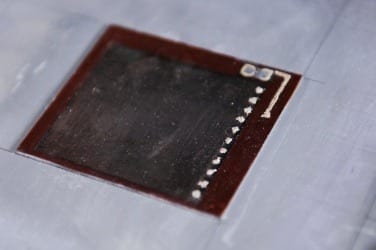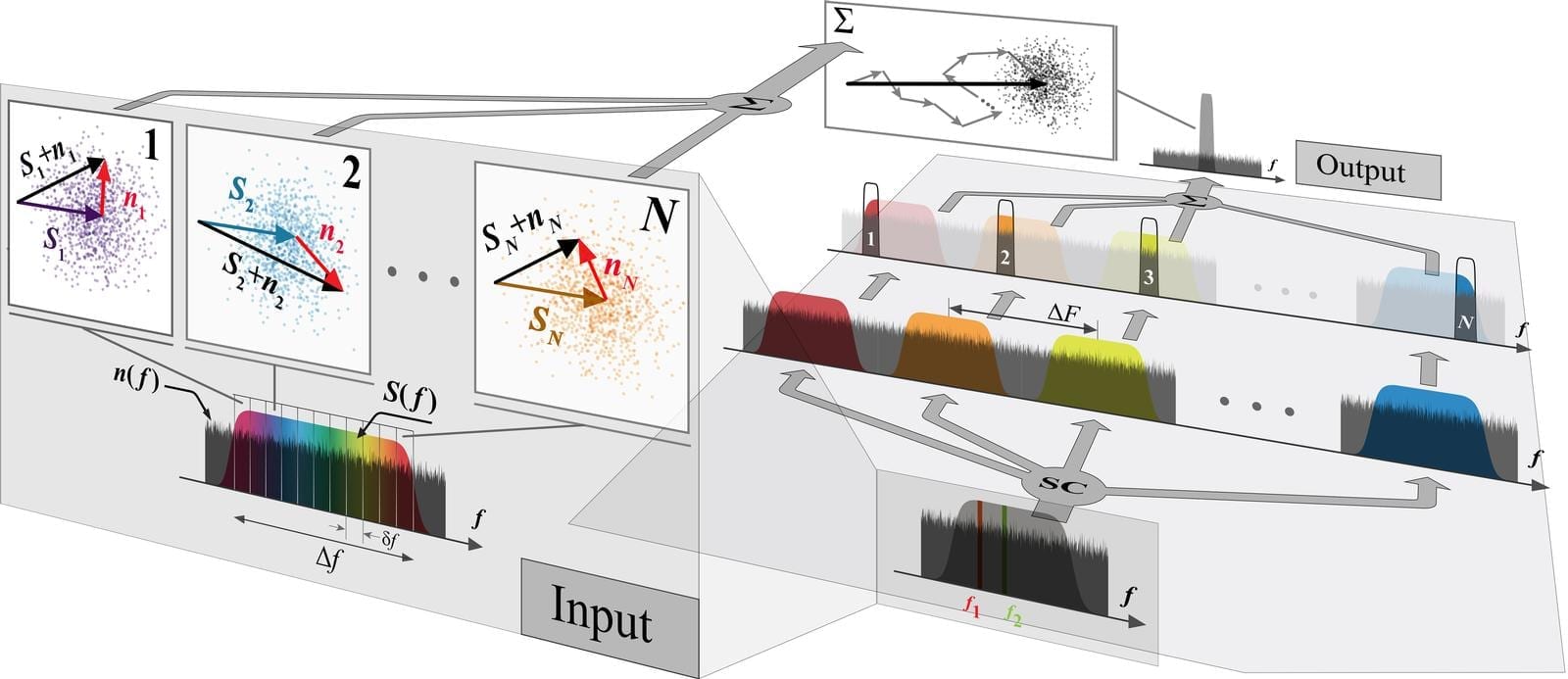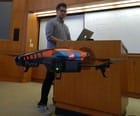
As thousands of bridges, parking garages and other structures age, improved methods for detecting deterioration could save lives and prevent economic disruption.
Major bridge failures in recent years have focused attention on the need to monitor America’s highway bridges and other infrastructure. As thousands of bridges, parking garages and other structures age, improved methods for detecting deterioration could save lives and prevent economic disruption.
Researchers at the Georgia Institute of Technology are developing a novel technology that would facilitate close monitoring of structures for strain, stress and early formation of cracks. Their approach uses wireless sensors that are low cost, require no power, can be implemented on tough yet flexible polymer substrates, and can identify structural problems at a very early stage. The only electronic component in the sensor is an inexpensive radio-frequency identification (RFID) chip.
Moreover, these sensor designs can be inkjet-printed on various substrates, using methods that optimize them for operation at radio frequency. The result would be low-cost, weather-resistant devices that could be affixed by the thousands to various kinds of structures.
“For many engineering structures, one of the most dangerous problems is the initiation of stress concentration and cracking, which is caused by overloading or inadequate design and can lead to collapse – as in the case of the I-35W bridge failure in Minneapolis in 2007,” said Yang Wang, an assistant professor in the Georgia Tech School of Civil and Environmental Engineering. “Placing a ‘smart skin’ of sensors on structural members, especially on certain high-stress hot spots that have been pinpointed by structural analysis, could provide early notification of potential trouble.”
Wang is collaborating with a team that includes professor Manos M. Tentzeris of the School of Electrical and Computer Engineering, and Roberto Leon, a former Georgia Tech professor who recently moved to Virginia Tech. The work is supported by the Federal Highway Administration.
This research was recently reported in IEEE Antennas and Wireless Propagation Letters, Volume 11, 2012, and International Journal of Smart and Nano Materials, Volume 2, 2011. Parts of this research were also presented at ASME 2012 Conference on Smart Materials, Adaptive Structures and Intelligent Systems (SMASIS) and several other conferences.
Antennas as Sensors
The Georgia Tech research team is focusing on wireless sensor designs that are passive, which means they need no power source. Instead, these devices respond to radio-frequency signals sent from a central reader or hub. One such reader can interrogate multiple sensors, querying them on their status at frequent intervals.
The researchers’ approach utilizes a small antenna mounted on a substrate and tuned to a specific radio frequency. This technique enables the antenna itself to function as a stress sensor.
As long as the structural member to which the antenna/sensor is affixed remains entirely stable, its frequency stays the same. But even a slight deformation in the structure also deforms the antenna and alters its frequency response. The reader can detect that change at once, initiating a warning months or years before an actual collapse.
“A key benefit of this technology is that it’s completely wireless,” Wang said. “It doesn’t require a battery, and you don’t have to climb around on bridges running long connecting cables.”
The research team has developed a prototype strain/crack sensor that has been successfully tested in the laboratory, Wang said. The simple device consists of a small piece of copper mounted on a polymer substrate, plus a 10-cent 1mm by 1mm RFID chip. The chip is used to distinguish each individual sensing unit from others. The simple sensor architecture allows it to be made at very low cost and to potentially be deployed in large quantities on any bridge.
Inkjet-Printed Circuits
More sophisticated designs are in the works. Tentzeris’ team is tackling an approach that produces strain sensors using different applications of inkjet printing technology.
One such design uses a silver-nanoparticle-based ink that is applied to a flexible or semi-flexible substrate, said Rushi Vyas, a Ph.D. student working with Tentzeris. The ink lays down a structure that can change properties in response to strain.
A second approach involves the use of inkjet-printed carbon-nanotube-based structures, Vyas said. In this case, the nanotubes themselves produce an altered response when subjected to deformation.
In laboratory testing, the team’s prototype sensors have demonstrated high sensitivity in response to even slight changes in metal structures, Wang said. The sensors have been able to reliably detect a degree of deformation change as low as tens of microstrains (one microstrain equals 0.0001 percent, or 1 part per million), and they can continuously monitor stress accumulation until the metal develops a severe crack.
One issue still being addressed is the capacity of the passive sensor to respond to a reader. A reader transmits a radio-frequency beam to a sensor, which utilizes that received energy to reflect a signal back to the reader.
But this technique can be rather inefficient, Vyas said. A signal from a reader might travel 50 feet, yet the sensor’s response might only travel back 10 feet. One issue is that readers are limited by FCC regulations, which govern how much power can be transmitted to the sensor.
The Latest Bing News on:
Remote Monitoring of Infrastructure
- How ISRO used satellite remote-sensing to analyse glacial lakes in Himalayason April 26, 2024 at 6:36 pm
This is the latest among a clutch of studies on glacial lakes that have highlighted the risks of glacial lake outburst floods (GLOFs), and their impact on infrastructure and settlements downstream of ...
- Smart infant monitoring company Owlet partners with Wheelon April 25, 2024 at 4:13 pm
“We’re thrilled to announce our strategic partnership with Owlet, a leader in smart infant monitoring. This collaboration marks a significant milestone in our mission to expand healthcare access and ...
- 5 Attack Trends Organizations of All Sizes Should Be Monitoringon April 25, 2024 at 2:34 pm
Recent trends in breaches and attack methods offer a valuable road map to cybersecurity professionals tasked with detecting and preventing the next big thing.
- Scale Computing Revolutionizes IT Efficiency With Virtual Desktop Infrastructure (VDI)on April 24, 2024 at 5:00 am
Scale Computing, a market leader in edge computing, virtualization, and hyperconverged solutions, today announced a campaign to promote its virtual desktop infrastructure (VDI) technology. For a ...
- Vietnam Pipeline Monitoring System Market Share, Analysis, Size, Prominent Players, and Forecast 2024 to 2032on April 17, 2024 at 2:13 pm
The recent analysis by Report Ocean on the “Vietnam Pipeline Monitoring System Market” Report 2024 to 2032 revolves around various aspects of the market, including characteristics, size and growth, ...
- Digi International Expands Monitoring Portfolio with Launch of Digi Connect Sensor XRT-M Powered by Digi Axesson April 16, 2024 at 7:30 am
Critical infrastructure and civil engineering projects Water/wastewater monitoring and remote management Environmental monitoring Industrial automation and control Tailored for businesses in precision ...
- Russian infrastructure disrupted by Ukrainian hackerson April 16, 2024 at 6:27 am
Operations of Russia's industrial sensor and monitoring infrastructure were claimed to have been disrupted by Ukrainian hacking operation Blackjack following a Fuxnet malware attack against ...
- Destructive ICS Malware ‘Fuxnet’ Used by Ukraine Against Russian Infrastructureon April 15, 2024 at 5:59 am
ICS malware Fuxnet allegedly used by Ukrainian hackers to disrupt industrial sensors and other systems belonging to a Russian firm.
- New Luzerne County Council Infrastructure Committee holding first meetingon April 13, 2024 at 5:00 pm
A Luzerne County Council committee formed to discuss infrastructure will meet for the first time ... with instructions for the remote attendance option posted under council’s online public meetings ...
- Wireless Telecom Infrastructure Market Share, Size, Key Players, Revenue, Growth Analysis, and Forecast to 2024 to 2032on April 11, 2024 at 9:49 pm
Request To Download Free Sample of This Strategic Report @- Wireless Telecom Infrastructure Market valued approximately USD 74.9 billion in 2017 is anticipated to grow with a healthy growth rate of ...
The Latest Google Headlines on:
Remote Monitoring of Infrastructure
[google_news title=”” keyword=”Remote Monitoring of Infrastructure” num_posts=”10″ blurb_length=”0″ show_thumb=”left”] [/vc_column_text]The Latest Bing News on:
Smart sensors
- Toshiba ML-EM62P(SS) Large Countertop Microwave with Smart Sensor, Now 13% Offon April 27, 2024 at 8:51 am
Universally acknowledged for their stellar contribution to consumer electronics, Toshiba's products need little introduction. One such exquisite offering is the Toshiba ML-EM62P (SS) Large Countertop ...
- Aqara Smart Lock U100 Review: Top-Tier Nuts and Boltson April 27, 2024 at 5:00 am
The Aqara smart lock U100 offers a winning deadbolt replacement option, especially for Apple users. Add a hub, and its capabilities expand even more.
- This is the best smart accessory you didn’t know you neededon April 27, 2024 at 2:40 am
The Nix Mini 2 is a smart, portable color wizard that scans colors in the real world and transposes them to digital formats. It syncs with your mobile devices.
- CropX now works with WiseConn smart irrigationon April 27, 2024 at 12:00 am
WiseConn smart irrigation users can now incorporate CropX Technologies’ digital farm management interface into their precision farming network. CropX’s data management system processes information ...
- Smart Grids, Safe Lands: Reducing Wildfire Risks With Technologyon April 25, 2024 at 3:48 pm
Smart-connected sensors, real-time data and machine learning can provide the insights utilities need to continually improve their wildfire planning and make faster decisions ...
- IoT Smart Sensors Industry Refocusing Market A Flight to Growth Skyrocketing Market Size Anticipatedon April 25, 2024 at 1:26 pm
Check out the latest research report from Report Ocean titled “IoT Smart Sensors Industry Refocusing Market: Trends Analysis from 2024 to 2032”. This report delivers accurate economic projections, ...
- How smart sensors, AI and other technology could change the marathonon April 20, 2024 at 7:41 am
The marathon of the future might look the same from the outside: humans running 26.2 miles in one of the most ancient sports on Earth. But a virtual version of those same humans could have run it ...
- How smart sensors, AI and other technology could change the marathonon April 19, 2024 at 4:59 pm
That will depend on having the detailed data in the first place – and much of this sensor technology is already on its way. Even casual runners wear smart watches that monitor them when they're ...
- Vietnam Smart Sensor Market Size, Share, Key Players, Revenue, Demand, and Forecast to 2024 to 2032on April 18, 2024 at 12:06 am
The Vietnam smart sensor market has witnessed remarkable growth in recent years, driven by factors such as the increasing adoption of IoT (Internet of Things) technologies across various industries ...
- The Evolution of Smart Technology: From Smart Homes to Smart Citieson April 17, 2024 at 6:45 am
In today’s fast-paced world, technology is advancing at an unprecedented rate, transforming the way we live, work, and interact with our surroundings. One of the most revolutionary developments in ...
The Latest Google Headlines on:
Smart sensors
[google_news title=”” keyword=”smart sensors” num_posts=”10″ blurb_length=”0″ show_thumb=”left”]










